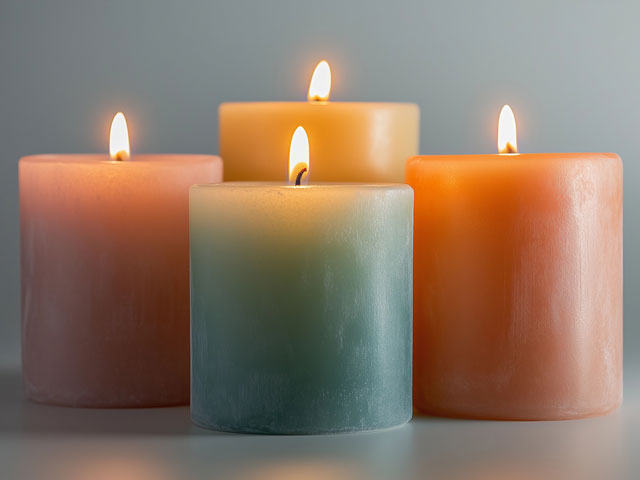Are Bath & Body Works Candles Toxic? Ingredients, Health Risks & Safer Alternatives
Burning candles to serve as air fresheners has been a thing for as long as you’ve been alive (and beyond).

Burning candles to serve as air fresheners has been a thing for as long as you’ve been alive (and beyond). Sure, candles have been providing light for humans for thousands of years. But let’s face it, White Sage & Tea, Champagne Toasft, and Mahogany Coconut - all Bath & Body Works candle scents - don’t exactly possess the longevity of those old melted tallow or beeswax candles of yore.
What Are the Ingredients of Bath and Body Works Candles
Bath & Body Works candles include paraffin wax, vegetable wax, synthetic fragrances, wicks, and potential allergens in their production. In short, not the best of stuff.
You can check the Bath & Body Works Safety Data Sheet if you want.
Concerns of Paraffin Wax
Paraffin wax forms the base of most Bath & Body Works candles. It's derived from petroleum, coal, or shale oil and emits volatile organic compounds (VOCs) like toluene and benzene when burned. Exposure to high concentrations of VOCs could pose respiratory risks, especially in poorly ventilated spaces.
Research from Stanford alongside the American Chemical Society suggests that chemicals in Paraffin Wax are carcinogenic. NPR corroborates this finding. Known Carcinogens are bad news for your desire to improve your aromatherapy with paraffin wax candles as health problems.
Potential Fragrance Issues
Synthetic fragrances in these candles create their signature aromas but might contain phthalates and other chemicals. Phthalates are linked to hormonal disruptions and respiratory irritation in sensitive individuals. Transparent labeling isn't standard, so identifying the exact chemicals can be challenging.
What Are the Wicks Made Of
Wicks in Bath & Body Works candles are typically made of cotton or a cotton-paper blend. Most do not use lead cores due to regulatory restrictions. However, metal cores, when present, might release small amounts of toxins during burning, increasing air pollution indoors.
What Allergens Exist in B&BW Candles
Common allergens include synthetic fragrances and dyes. Fragrance blends might trigger allergic reactions like headaches, sneezing, or skin irritation in sensitive individuals. If you have fragrance-related sensitivities, choosing fragrance-free or natural alternatives is wise.
What Are The Health Implications of Burning Bath and Body Works Candles
Burning Bath & Body Works candles can release substances that may impact air quality and health. Paraffin wax, a primary component in these candles, generates volatile organic compounds (VOCs) during combustion. These VOCs, such as toluene and benzene, are linked to potential respiratory issues and long-term exposure risks, particularly in poorly ventilated spaces.
Synthetic fragrances, often used to create distinct scents, may contain compounds like phthalates. Phthalates are associated with endocrine disruption and may exacerbate symptoms for individuals with asthma or other respiratory sensitivities. Prolonged exposure to synthetic fragrances in enclosed areas increases potential health concerns.
The wicks may also contribute to health risks. While most wicks are cotton-based, trace amounts of heavy metals could be present in those with metal cores. Metal-core wicks have been tied to the release of harmful substances like lead into the air when burned, although the use of lead-based wicks in the US has been banned since 2003.
People with sensitivities may experience allergies or irritations from common ingredients like synthetic dyes and fragrances. Frequent exposure to these allergens, especially in frequent candle users, could lead to skin irritation, headaches, or worsened respiratory conditions. Opting for candles made with natural waxes and essential oils can mitigate these risks.
What Candle Brands Are Considered Safe & Non-Toxic
Several candle brands prioritize safe, non-toxic ingredients to minimize health and environmental concerns. Choosing candles from these brands ensures a cleaner burn time and reduces exposure to potentially harmful chemicals sometimes found in the perfumes and more of scented candles. Always check labels for clarity on materials and consider options with natural formulations.
Bee Hive Candles
Uses 100% pure beeswax and cotton wicks, avoiding synthetic additives. These candles burn cleanly, emitting negative ions that help reduce airborne pollutants.
Noxi Candle Co.
Made with soy wax and phthalate-free fragrances, ensuring reduced VOC emissions. They include plant-based essential oils for natural scents.
Grow Fragrance
Produces candles with soy-based wax and certified toxin-free ingredients. Their fragrances derive from essential oils and botanical extracts.
Pure Plant Home
Offers coconut wax candles with lead-free cotton wicks. The candles are free from synthetic dyes and artificial fragrances, making them allergy-friendly.
Big Dipper Wax Works
Crafts eco-friendly candles using beeswax, natural dyes, and essential oils. They focus on sustainable sourcing practices.
Fontana Candle Co.
Features Safe Scent Seal-certified candles made with beeswax, coconut oil, and toxin-free fragrances. They avoid paraffin and synthetic chemicals.
Eco Candle Co.
Uses soy wax, cruelty-free ingredients, and sustainably harvested materials. Their candles are free of phthalates, lead, and petroleum byproducts.
Frequently Asked Questions (FAQs)
How Do Bath & Body Works Candles Compare To Yankee Candles?
If nothing else, they offer different scents. Both companies offer soy candles for sale.
Are BBW Candles Vegan?
We are not entirely sure if they are Vegan. We are currently conducting research.
Are BBW Candles safe for dogs?
BBW candles are as safe for dogs as they are humans. Which is to say that you should consider the chemical composition of the candles you purchase and how that affects the air that you are Rex breath.
Would I let my dog eat a candle? No, I wouldn't want them ingesting the particulate matter regardless if the label reads natural ingredients.
Do non-toxic candles cause respiratory problems?
While we aren't scientists who specialize in the toxicity of candles, it is far more unlikely for a non-toxic candle to cause respiratory problems.